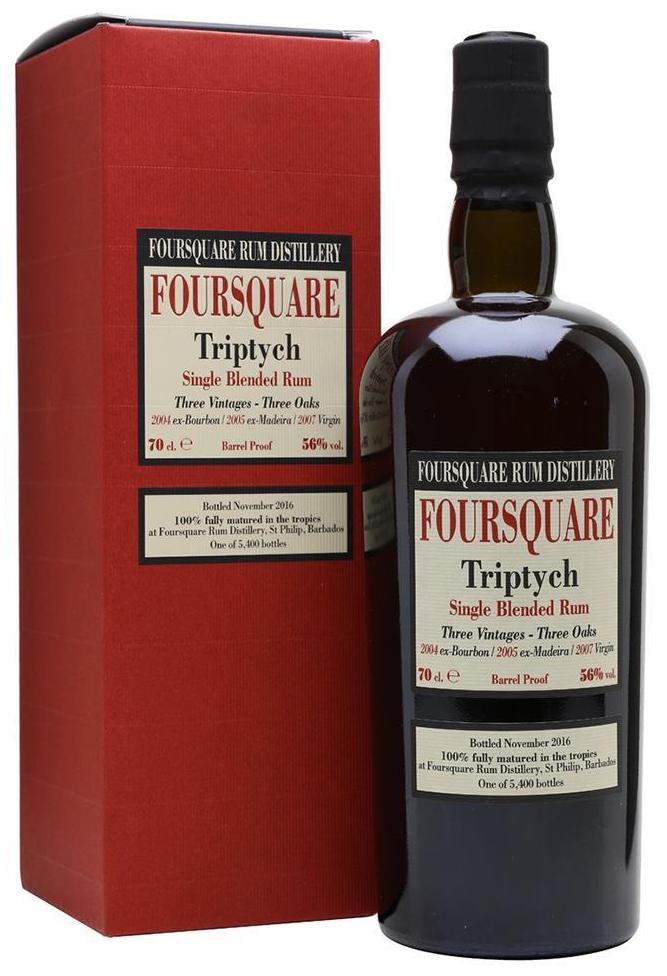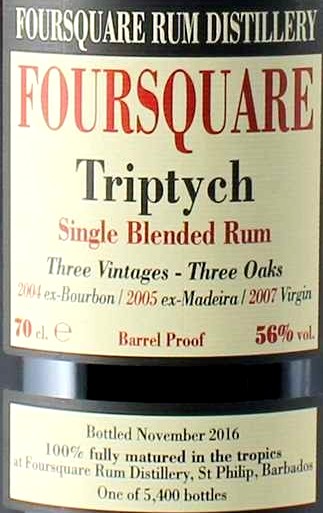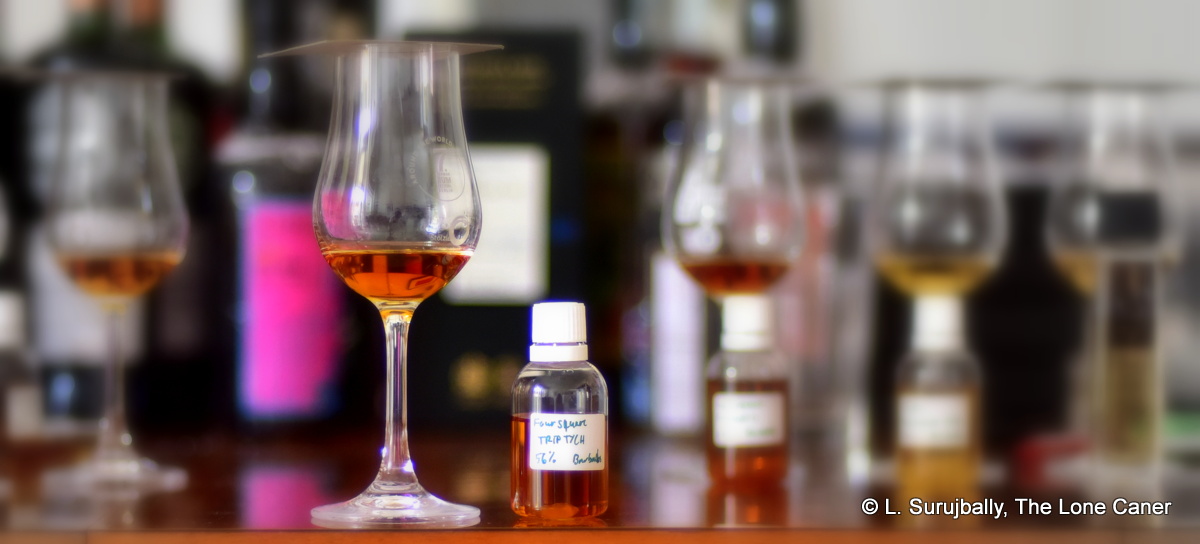In my more whimsical moments, I like to think Richard Seale was sweating a bit as he prepared the Triptych. Bottled in November 2016 and released in the 2017 season, it came right on the heels of the hugely successful and awe-inducing unicorn of the 2006 10 Year Old which had almost immediately ascended to near cult status and stayed there ever since. How could any follow-up match that? It was like coming up on stage after Mighty Liar just finished belting out “She Want Pan” hoping at least not too suck too bad in comparison. He need not have worried — the Triptych flew off the shelves every bit as fast as its predecessor (much to his relief, I’m sure), though in the years that followed people never quite mentioned it in the same hushed tones, with the same awe, and with the same whimpers of regret, as they did the 2006. Some, yes…but not to the same extent.
That may just be a little unfair though, because the Triptych is an enormously satisfying rum, another one of the limited “Collaboration” series between Foursquare and Velier 1 that are notable for their visually elegant simplistic design, their full proof strength and their polysyllabic titles which may have reached their apogee with the Plenipotenziario (while there’s usually a stated rationale behind the choice, I’ve always suspected were a tongue-in-cheek wink at all of us, a sort of private thing between the two men behind it).
 It is also a rum that was made to deliberately showcase other aspects of the way a pot-column blend could be made to shine. Some call it “innovation” but honestly, I think the word is tossed around a bit too cavalierly these days, so let’s just say there’s always another way to blend various aged components, and Foursquare are acknowledged masters of the craft. Most blends are various aged rums, harmoniously mixed together: here, three differently aged elements, or ‘sub-blends’, were joined in a combination – a triptych, get it? – that could be appreciated as balanced synthesis of all.
It is also a rum that was made to deliberately showcase other aspects of the way a pot-column blend could be made to shine. Some call it “innovation” but honestly, I think the word is tossed around a bit too cavalierly these days, so let’s just say there’s always another way to blend various aged components, and Foursquare are acknowledged masters of the craft. Most blends are various aged rums, harmoniously mixed together: here, three differently aged elements, or ‘sub-blends’, were joined in a combination – a triptych, get it? – that could be appreciated as balanced synthesis of all.
These three pieces were [1] a 2004 pot-column blend matured in ex-Bourbon casks [2] a 2005 pot-column blend aged in ex-Madeira and [3] a 2007 pot-column blend matured in brand new (‘virgin’) oak casks. The actual duration of ageing of each before they were blended and then transferred to the final casks for completion of the blending and ageing process, is not known, though Steve James, who has what is probably the most comprehensive background notes on the Triptych, notes that the component aged in virgin oak was aged for six years before transfer (six months is more common due to the active nature of the wood, which in this instance also necessitated a larger proportion of pot still distillate of the blend in these casks).
Clearly this made for a very complex blend of disparate profiles, any one of which could unbalance the whole: the musky, darker notes of the bourbon, the dry sweet acidity of Madeira and the aggressive woody characteristic of new oak casks. At the risk of a spoiler, the rum mostly sailed past these concerns. Nosing it experimentally at first, I was struck by how delicately perfumed it was, quite dry, rather mildly fruity and much more restrained than the solid weight of the Principia that lurked in the glass alongside – this was probably a consequence of the lesser-but-still-solid proof point of 56% ABV. The fruits stayed in the background for most of the experience, and the dominant aspect of the nose was a remarkably restrained woodiness – mild pencil shavings, vanilla, musty books, old cardboard, charcoal, and damp mossy forest floors in the morning. There were also hints of crushed walnuts, almonds and spices like marsala, cumin and rosemary, plus coconut shavings, flambeed bananas and overripe peaches, but these stayed well back throughout.
The rum came into its own on the palate, where even with its relatively few core flavours, it surged to the front with an assurance that proved you don’t need a 99-piece orchestra to play Vivaldi. The rum was thick, rich and – dare we say it? – elegant: it tasted of blood oranges, coconut milk, honey, vanilla and cinnamon on the one hand, and brine, floor polish, cigarette ash (yes, I know how that sounds) on the other, and in the middle there was some sweet sour elements of sauerkraut, licorice, pickles and almonds, all tied together in a bow by a sort of lingering fruitiness difficult to nail down precisely. If the rum had any weakness it might be that the dry finish is relatively lackluster when compared against the complexity of what had preceded it: mostly vanilla, oak, brine, nuts, anise, and little fruit to balance it off.
 Clearly the makers, with three aged blends being themselves blended, had to chose between various competing priorities, and balance a lot of different aspects: the various woods and their influence; the presence and absence of salt or sweet or sour or acidity; more strength versus less; the effect of the tannins working with subtler aromatics and esters. That such a tasty rum emerged from all of that is something of a minor miracle, though for my money I felt that the slightly lesser strength made it less indistinct than the stronger and more precisely dialled in coordinates of the 2006 and Principia (which were my comparators along with the Criterion, the 2004 and the Zinfadel).
Clearly the makers, with three aged blends being themselves blended, had to chose between various competing priorities, and balance a lot of different aspects: the various woods and their influence; the presence and absence of salt or sweet or sour or acidity; more strength versus less; the effect of the tannins working with subtler aromatics and esters. That such a tasty rum emerged from all of that is something of a minor miracle, though for my money I felt that the slightly lesser strength made it less indistinct than the stronger and more precisely dialled in coordinates of the 2006 and Principia (which were my comparators along with the Criterion, the 2004 and the Zinfadel).
Perhaps it was too much to hope that the lightning could be trapped in a bottle in quite the same way a second time. The UK bloggers who are so into Foursquare bottlings all claim the thing is as great as the 2006, “just different” but I only agree with the second part of that assessment – it’s different yes, and really good, but nope, not as great. And the subsequent sales values are telling: as of 2021 the 2006 usually auctions for four figures (outdone only by the Velier 70th Destino which is regularly and reliably approaching two thousand pounds) while the Triptych still goes for around two to three hundred.
All that said, I must admit that in the main, I can’t help but admire the Triptych. It’s no small feat to have blended it. To take several ex-bourbon blends and put those together, or to marry a few aged and unaged components, is one thing. To find a way to merge three distinctly separate and differently-aged pot-column blends, to age that and come out the other end with this rum, is quite another. So much could have gone wrong, and so much didn’t — it’s a testament to the hard work and talent of Richard Seale and his team at Foursquare.
(#856)(87/100)
Other Notes
- Outturn is 5400 bottles. Based on the youngest aged portion of the blend you could say it’s a 9 YO rum, though the label makes no such statement
- Given that it came out several years back, clearly others have by now reviewed the rum: Rum Diaries Blog gave it its full throated endorsement and is, as noted, the most deeply informative article available; The Fat Rum Pirate’s 4½-star review is very good; Single Cask Rum was more dismissive with a 78/100 score, and good background notes – I particularly liked his point about the pre-sales hype coming from the perception that it was a Foursquare/Velier product (based on the label) when in fact this was not the case (it was entirely Foursquare’s work). The Rum Shop Boy loved it to the tune of 97 points, while Rum Revelations awarded 94 in a comparative tasting and Serge gave what for him is a seriously good rating of 90.
- I do indeed have a bottle of the Triptych, but the review was done from a sample provided by Marco Freyr. Big hat tip, mein freund….
Historical Note
I’ve remarked on this before, most recently in the opinion piece on flipping, but a recap is in order: when the 2006 ten year old was released in 2016, it flew off the shelves so fast that it became a sort of rueful joke that all online establishments sold out five minutes before the damn things went on sale.
This situation angered a lot of people, because not only did it seem as if speculators or hoarders were buying however much they wanted (and indeed, being allowed to, thereby reducing what was available for people who genuinely wanted to drink the things and share the experience) but almost immediately bottles turned up on the FB trading clubs at highly inflated prices — this was before they were mostly closed down and the action shifted to the emergent auction sites like Rum Auctioneer.
This was seen as a piss-poor allocation and sales issue and some very annoyed posts were aimed at Velier and Foursquare. By the time the Triptych came out, not only were twice as many bottles released, but Richard and Luca came up with a better method of allocation that was the forerunner of the current systems now in play for many of their limited releases. And that’s on top of Richard’s own personal muling services around the festival circuit, to make sure the uber-fans got at least a sample, if not a whole bottle (which always impressed me mightily, since I don’t know any other producer who would do such a thing).

One day I’m sure I’ll get to try this one ?
As you highlight, to blend at this level of complexity and create such a result I can’t help but be in respectful admiration.
PS. I had to look up Mighty Liar. Calypso music over breakfast was a different start to the day!
Suggest you also look up “King Liar” by Lord Nelson for a good laugh 🙂